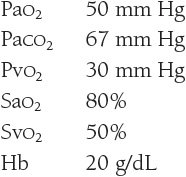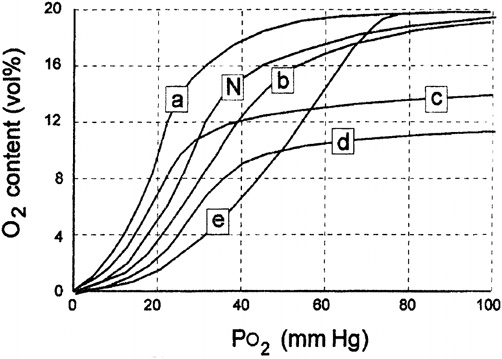a. A change in PCO2 from 40 to 46 mm Hg
b. A change in pH from 7.4 to 7.3
c. A decrease in core body temperature from 37°C to 32°C
d. An increase in erythrocyte [2,3-bisphosphoglycerate]
e. Transfusion of blood with a higher P50 than normal
65. A 24-year-old woman presents to her family physician with intractable hiccups. The patient is instructed to breathe into and out of a bag in order to rebreathe exhaled CO2. In the blood, the majority of CO2 is transported as which of the following forms?
a. Bicarbonate
b. Carbaminohemoglobin
c. Carbonic acid
d. Carboxyhemoglobin
e. Dissolved CO2
66. A 67-year-old woman with a history of venous thromboembolism is placed on warfarin (Coumadin; Bristol-Myers Squibb Company, New York, NY USA) prophylactically. The blood concentration of Coumadin becomes too high and bleeding occurs. The bleeding can best be treated by the administration of which of the following?
a. Fibrinogen
b. Platelets
c. Protein C
d. Thrombin
e. Vitamin K
67. A 37-year-old man presents with low exercise tolerance. Blood work shows a normal hematocrit and Hb concentration but a decreased P50. Which would be true of his oxyhemoglobin transport and dissociation?
a. Hb’s affinity for oxygen is increased
b. O2 loading at the alveolar-capillary level is less than normal
c. O2 saturation is lower than normal at any PaO2
d. O2 unloading is increased at the tissue level
e. The differential diagnosis includes a point mutation resulting in increased binding of H+ to his Hb chains.
68. A 35-year-old woman presents to her family physician’s office with fatigue of at least 3 months’ duration. Her only explanation is that keeping up with her twin 4-year-olds really tires her out, and she does not even have enough energy to make nutritious meals for her and her husband. Vital signs and ECG are normal, but a third heart sound is heard with auscultation and she is pale. Blood results are as follows: Hb, 8 g/dL; hematocrit, 30%; MCV, 115 fL; WBC, 8000/μL; platelets, 200,000/μL. A deficiency of which of the following substances can most likely account for these findings?
a. Folate
b. Glucose-6-phosphatase
c. Iron
d. Niacin
e. Zinc
69. A 65-year-old slightly cyanotic man presents to his physician complaining of pruritus and nose bleeds. A blood test reveals a hematocrit of 62%, leading to the diagnosis of polycythemia vera. Treatment includes aspirin to prevent thrombosis and periodic phlebotomy to reduce the hematocrit. The reduction in hematocrit is beneficial because it does which of the following?
a. Decreases cardiac output
b. Increases arterial oxygen content
c. Increases arterial oxygen saturation
d. Reduces blood velocity
e. Reduces blood viscosity
70. A 65-year-old man with chronic bronchitis is admitted to the emergency department with cyanosis and shortness of breath. Arterial and venous blood samples show the following:

What do these data reveal about the patient’s gas exchange and transport?
a. Arteriovenous oxygen content difference is lower than normal
b. Dissolved CO2 content in the arterial blood is lower than normal
c. Dissolved O2 content in the venous blood is higher than normal
d. Oxygen extraction is higher than normal
e. Oxyhemoglobin content in the arterial blood is lower than normal
71. A 23-year-old man with a ruddy complexion presents with chief complaints of headache, dizziness, and lethargy. Blood analysis shows erythrocytosis and a P50 of 20 mm Hg. He denies any history of tobacco smoking and is unaware of any other exposure to carbon monoxide or nitrites. Which of the following is a probable cause for these findings?
a. α-Thalassemia-2
b. β-Thalassemia major
c. High-O2 affinity hemoglobinopathy
d. Low-O2 affinity hemoglobinopathy
e. Sickle cell trait
72. A 42-year-old woman presents to her doctor’s office with heavy menstrual bleeding for up to 2 weeks’ duration for each of the past five cycles. She also reports that she has a tendency to bruise easily, and has had several episodes of epistaxis over the past couple of months. Blood analysis shows: Hb, 8 g/dL; hematocrit, 24%; MCV, 70; platelet count, 230,000/μL. Which of the following is a likely cause of her bleeding disorder?
a. Aplastic anemia
b. Hemophilia
c. Nonsteroidal anti-inflammatory drugs
d. Vitamin B12 deficiency
e. von Willebrand disease
73. A 26-year-old woman presents at the obstetrician’s office for her second trimester evaluation. Which of the following values would normally be less in the fetus than in the mother?
a. Affinity of Hb for oxygen
b. Cardiac glycogen content
c. Cardiac output/kg body weight
d. Erythrocyte binding of 2,3-bisphosphoglycerate
e. Hb concentration
74. A 61-year-old man presents to his family physician with the chief complaint of frequent diarrhea accompanied by weight loss. He reports a tendency to bruise easily and laboratory data reveal a PT of 19 seconds (normal, 11–14 seconds). The bruising and prolonged PT can be explained by a decrease in which of the following vitamins?
a. A
b. C
c. D
d. E
e. K
75. A 52-year-old man is brought to the emergency department with severe chest pain. Angiography demonstrates a severe coronary occlusion. A thrombolytic agent is administered to reestablish perfusion. Which of the following does the thrombolytic agent activate?
a. Heparin
b. Kininogen
c. Plasminogen
d. Prothrombin
e. Thrombin
76. A 32-year-old woman presents to the emergency department with a chief complaint of acute shortness of breath and right-sided chest pain, which increases during inspiration. She does not have a cough or fever, and does not have a history of asthma or other respiratory disease. She has not been ill or immobile, but reports having taken oral contraceptives for 8 years until shortly before conceiving her first child about 2 years ago. The family history is notable for her mother who died of a pulmonary embolism. Her respiratory rate is 25 breaths/min and her heart rate is 110 beats/min. Chest x-ray is normal, but a ventilation/perfusion scan reveals a possible pulmonary embolism. Which of the following blood disorders is associated with a hypercoagulable state?
a. Activated protein C resistance
b. Antithrombin III (AT-III) excess
c. Disseminated intravascular coagulation (DIC)
d. Hypoprothrombinemia
e. Idiopathic thrombocytopenic purpura
77. A 9-year-old African American boy is brought to the emergency department by his mother who states that he was complaining of muscle aches and pain while playing basketball, which became worse whenever he was running up and down the court. She reports that he was sick with a fever last week, but she thought he was feeling better so she let him go to his summer basketball camp. Blood tests show anemia, increased reticulocyte count, and crescent-shaped cells. Hb electrophoresis confirms the presence of HbS. The primary mechanism for the change in RBC shape during a sickle cell crisis is which of the following?
a. A decrease in erythrocyte volume during dehydration
b. A rightward shift in the oxyhemoglobin dissociation curve of HbS compared with normal
c. Low levels of erythropoietin
d. Polymerization of HbS as it is deoxygenated
e. The presence of antibodies against the red blood cell membrane
78. A 67-year-old man with chronic bronchitis is brought to the emergency department exhibiting labored breathing and cyanosis. The presence of cyanosis is due to which of the following?
a. Decreased O2 unloading at the tissue capillary level
b. Decreased oxyhemoglobin content in the capillary blood
c. Decreased total arterial oxygen content
d. Increased concentration of deoxygenated Hb
e. Increased hematocrit
79. A 26-year-old pregnant woman is diagnosed with placenta previa, which requires premature delivery of her fetus of 28-week gestation. A blood sample is taken from both the mother and the newborn infant for determination of the oxyhemoglobin saturation curve. If curve N in the figure below is the oxyhemoglobin saturation curve of the mother who has normal HbA, which of the curves is most likely obtained from the premature infant?

a. a
b. b
c. c
d. d
e. e
Stay updated, free articles. Join our Telegram channel

Full access? Get Clinical Tree


